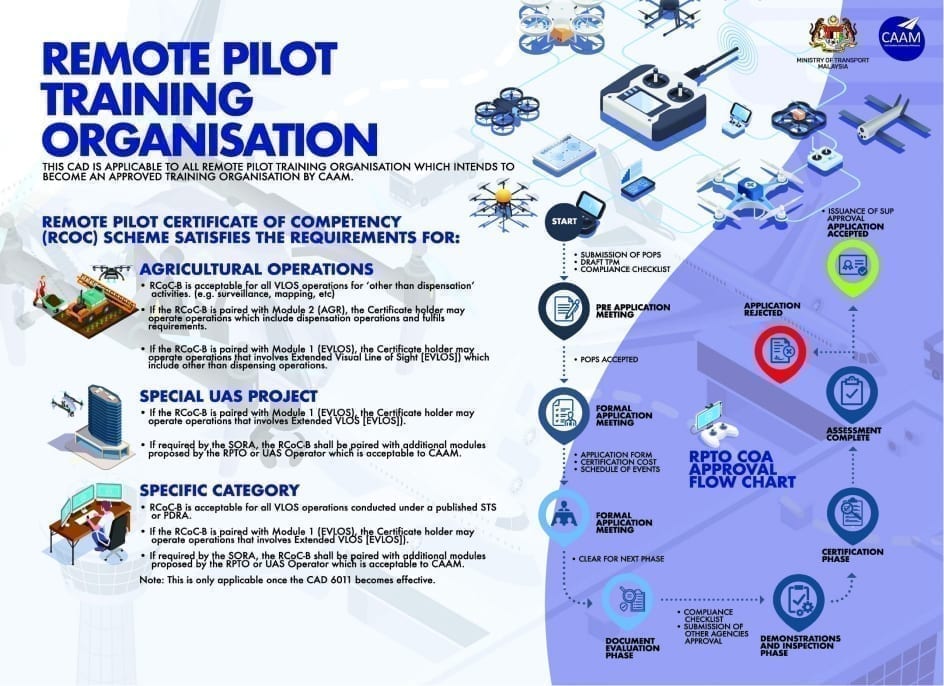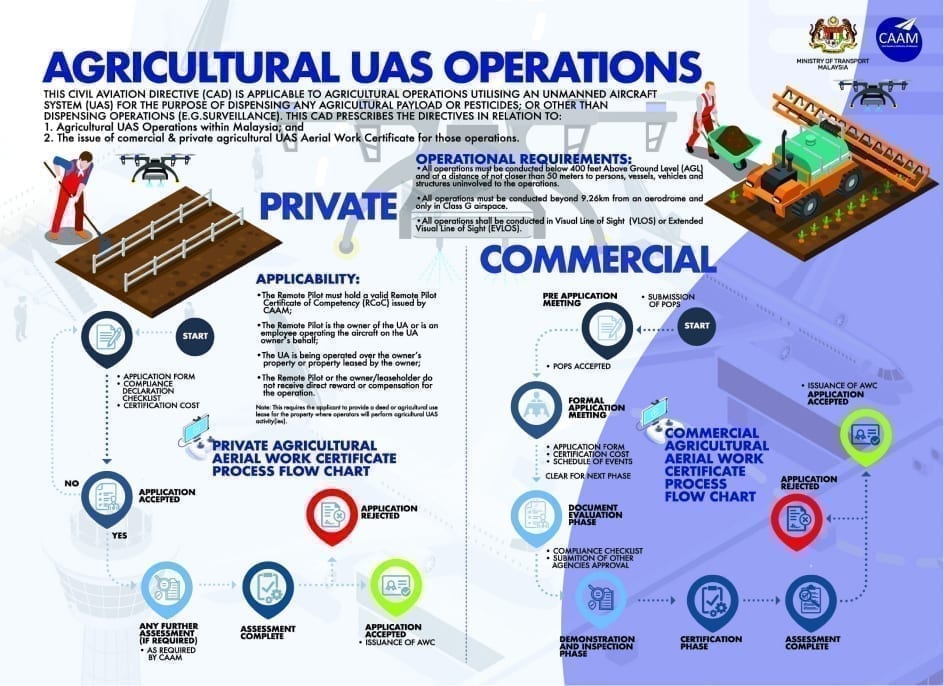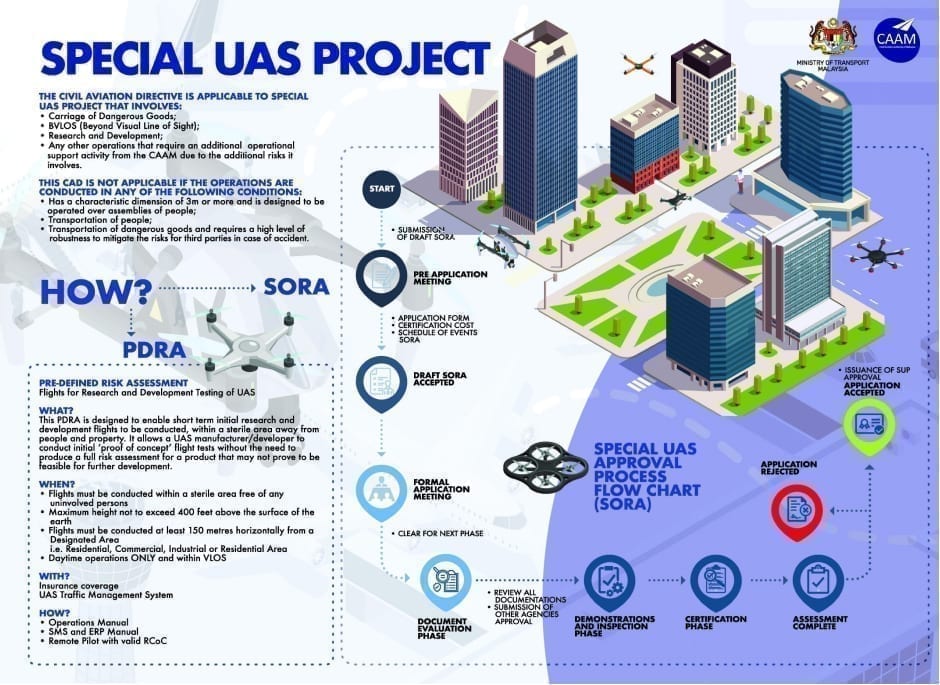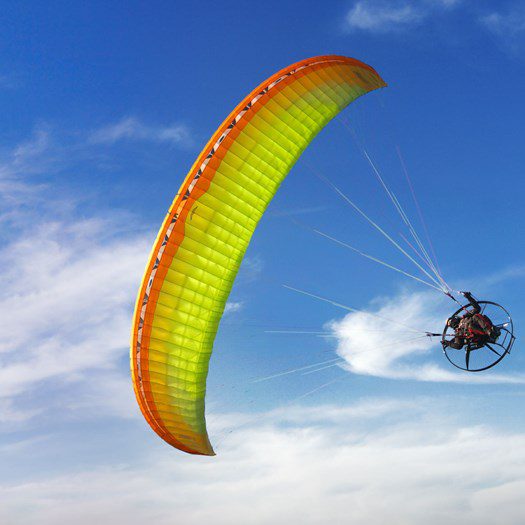Hi there!
For your information, all UAS/Drone flight activities are bound to the Civil Aviation Regulation and its Civil Aviation Directives. However, CAAM is not the only agency with legislations on UAS.
The following are the types of approval that CAAM issues out with regards to UAS/Drones.
| Ser. | Type of Approval/ Authorisation | Description | Click here to know more |
|---|---|---|---|
| 1 | Standard Authorisation To Fly (ATF) | Low risk drone operations such as: | Link to “Standard Authorisation to Fly” |
| • Flown within VLOS or EVLOS (with a maximum of one Visual Observer) | |||
| • No spraying or dispensation operations | |||
| • Less than 400ft AGL, unless otherwise approved by ATC | |||
| 2 | Certificate of Approval (COA) | Given to Remote Pilot Training Organisation (RPTO) to carry out competency training and evaluation for RCOC-B and its Modules | Link to “Application for Remote Pilot Training Organisation (RPTO) Certificate of Approval” |
| (Refer to CAD 6011 Part I) | |||
| 3 | Agricultural UAS Operations under Unmanned Aerial Work Certificate (UAWC) | When a drone is used for agricultural UAS Operations such as: | Link to Application for Commercial Agricultural UAS Operations (AGR) Unmanned Aerial Work Certificate (UAWC). |
| • Dispensing any ‘agricultural payload’ intended for plant nourishment, soil treatment, propagation of plant life, or pest control; or | |||
| • Engaging in dispensing ‘agricultural payload’ and surveillance activities directly affecting agriculture, horticulture, or forest preservation, but not including the dispensing of live insects. | Link to Application for Private Agricultural UAS Operations (AGR) Unmanned Aerial Work Certificate (UAWC). | ||
| (Refer to CAD 6011 Part II) | |||
| 4 | Special UAS Project (SUP) Approval | When a drone is used for the following operations: | Link to Application for Special UAS Project Approval |
| • Carriage of items, inclusive of carriage of Dangerous Goods; | |||
| • BVLOS; | |||
| • Research and Development; | |||
| • Any other operations that require an additional operational support activity from the CAAM due to the additional risks it involves. | |||
| (Refer to CAD 6011 Part V) |
Civil Aviation Regulation 2016 (CAR 2016) (Regulation 140-144)
- Regulation 140 – Unmanned aircraft system
- Regulation 141 – Aerial work involving unmanned aircraft system
- Regulation 142 – Small unmanned aircraft
- Regulation 143 – Small unmanned surveillance aircraft
- Regulation 144 – Unmanned aircraft system of more than 20 kilograms
What does this mean?
(140) Unmanned aircraft system
This regulation states that flying unmanned aircraft systems (drones) is not allowed in certain areas, including class A, B, C, or G airspace, within an aerodrome traffic zone, and higher than 400 feet from the ground, unless authorized by the Authority. To obtain authorization, an application must be made in accordance with regulation 189. Dropping any object from a drone is also prohibited. “Class A, B, C, or G airspace” refers to airspace designated by the Chief Executive Officer.
So, in summary, class A, B, and C is a controlled airspace while class G is an uncontrolled airspace. In general, a controlled airspace is typically an airspace controlled by air traffic controller. Despite uncontrolled airspace is not controlled by ATC, under regulation 140 you still cannot fly your UAS without authorisation from the Authority.
(141) Aerial work involving unmanned aircraft system
This regulation states that using an unmanned aircraft system (drone) for aerial work is not allowed without authorization from the Authority. To obtain authorization, an application must be made in accordance with regulation 189. This directive will provide a guideline, the do’s and don’ts to agricultural operations, utilizing an unmanned aircraft system for the purpose of dispensing any agricultural payload or pesticide, or other than dispensing operations for examples surveillance and mapping.
(142) Small unmanned aircraft
This regulation states that the person in charge of a small unmanned aircraft can fly it if they are confident that it can be done safely. The person in charge must keep direct and unaided visual contact with the drone to monitor its flight path and avoid any potential collisions with other aircraft, people, vehicles, vessels, or structures.
(143) Small unmanned surveillance aircraft
This regulation prohibits flying small unmanned surveillance aircraft in certain circumstances without authorization from the Authority. These circumstances include flying over or within 150 meters of any designated area, flying over an open-air assembly of more than 1,000 people, and flying within 50 meters of any vessel, vehicle, structure, or person, except during take-off and landing when the distance should be 30 meters. An application for authorization must be made in accordance with regulation 189. “Designated area” refers to any area used for residential, commercial, industrial, or recreational purposes.
(144) Unmanned aircraft system of more than 20 kilograms.
This regulation prohibits flying unmanned aircraft systems weighing over 20 kilograms (without fuel) without authorization from the Authority. An application for authorization must be made in accordance with regulation 189.
The Malaysian Airspace Class A, B, C and G can be found within the AIP. An example of the airspace, once plotted can be found below. The table below is the extract from AIP on Classification of Airspace
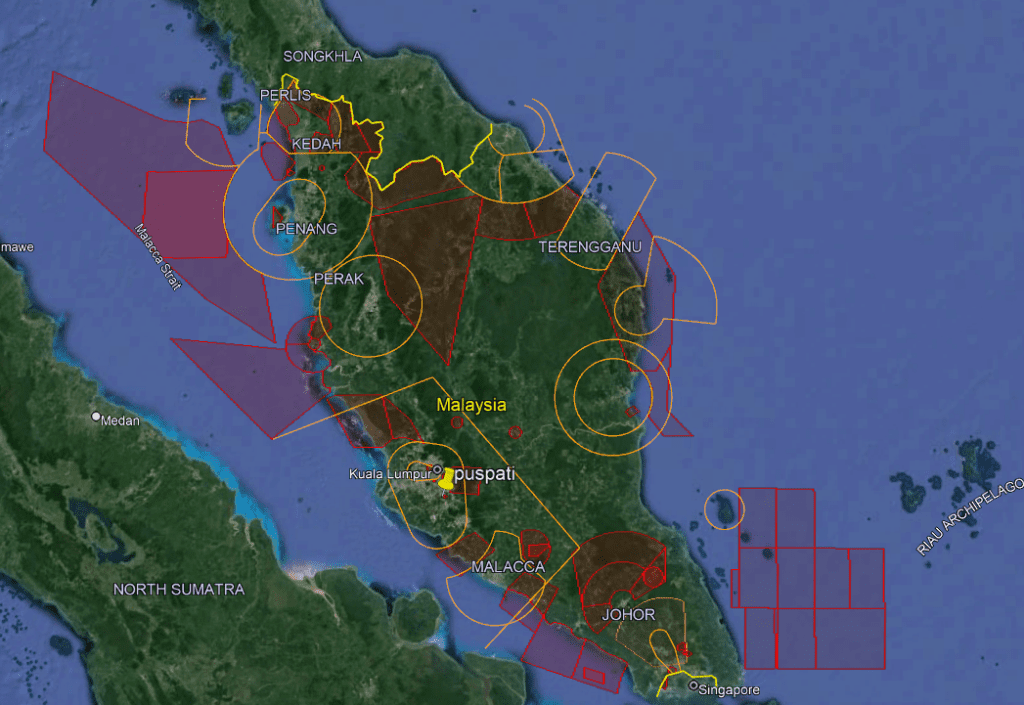
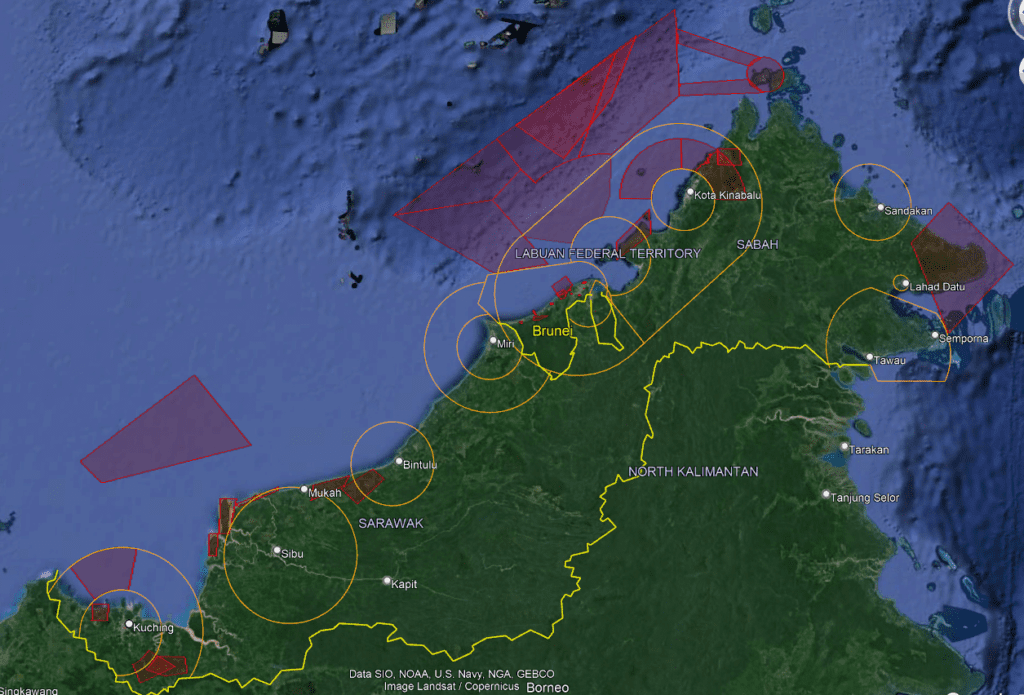
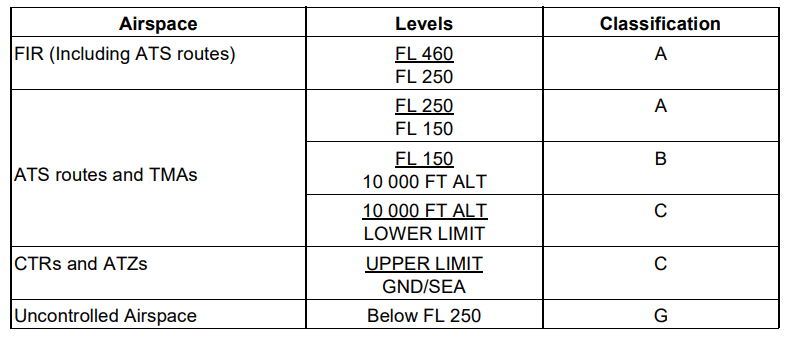
| Series | Name of Agency | Job Function | Link |
|---|---|---|---|
| 1 | Standard and Industrial Research of Malaysia (SIRIM) | Ensure UAS brought in meets the safety standard requirement for electronics equipment. | https://www.sirim.my/ |
| 2 | Malaysian Communications and Multimedia Commission (MCMC) | MCMC regulates and promotes the communication and multimedia industry and delicately balances the overall interest of the consumer, industry and investor. The allocated frequency for the Control and Non-Payload Communications (CNPC) and payload links 433MHz to 435 MHz, 2400 MHz to 2500 MHz and 5725 MHz to 5875 MHz. An Apparatus Assignment shall be requested if the frequency is differing than the allocated frequencies. | https://www.mcmc.gov.my/en/home |
| 3 | Department of Survey and Mapping Malaysia (JUPEM) | If the UA is capable of undertaking surveillance and measuring activities (such as aerial photo, aerial mapping, Lidar etc.) then the UAS operator must seek an approval from the Department of Survey and Mapping. The Department of Survey and Mapping's responsibility also extends to liaising with CGSO, ATM-BSPP and RMP to conduct the background check and ensuring the level of security of the proposed area of operation. | https://www.jupem.gov.my/ms |
| 4 | Chief Government and Security Office (CGSO) | Governs all Kawasan Larangan Tempat Larangan and Sasaran Penting (KLTL and SP) | https://www.cgso.gov.my/en/ |
| 5 | Wisma Tanah dan Ukur Sabah | Additional authorisation required for UA operations in Sabah | https://jtu.sabah.gov.my/ |
| 6 | Office of Premier of Sarawak | Additional authorisation required for UA operations in Sarawak. | https://premier.sarawak.gov.my/web/home/index/ |
- For your information, CAAM will ensure coordination between agencies (JAKUAS) are done via the pre-application meeting for the following approval:
- Remote Pilot Training Organisation
- Agricultural UAS Operations (Unmanned Aerial Work Certificate)
- Special UAS Project
- But for an Authorisation To Fly (ATF), applicant must ensure that they contact the other agencies prior to applying to CAAM for the Authorisation to Fly approval.
| Ser. | Type of Approval/ Authorisation | Description | Click here to know more |
|---|---|---|---|
| 1 | Standard Authorisation To Fly (ATF) | Low risk drone operations such as: | Link to “Standard Authorisation to Fly” |
| • Flown within VLOS or EVLOS (with a maximum of one Visual Observer) | |||
| • No spraying or dispensation operations | |||
| • Less than 400ft AGL, unless otherwise approved by ATC | |||
| 2 | Certificate of Approval (COA) | Given to Remote Pilot Training Organisation (RPTO) to carry out competency training and evaluation for RCOC-B and its Modules | Link to “Application for Remote Pilot Training Organisation (RPTO) Certificate of Approval” |
| (Refer to CAD 6011 Part I) | |||
| 3 | Agricultural UAS Operations under Unmanned Aerial Work Certificate (UAWC) | When a drone is used for agricultural UAS Operations such as: | Link to Application for Commercial Agricultural UAS Operations (AGR) Unmanned Aerial Work Certificate (UAWC). |
| • Dispensing any ‘agricultural payload’ intended for plant nourishment, soil treatment, propagation of plant life, or pest control; or | |||
| • Engaging in dispensing ‘agricultural payload’ and surveillance activities directly affecting agriculture, horticulture, or forest preservation, but not including the dispensing of live insects. | Link to Application for Private Agricultural UAS Operations (AGR) Unmanned Aerial Work Certificate (UAWC). | ||
| (Refer to CAD 6011 Part II) | |||
| 4 | Special UAS Project (SUP) Approval | When a drone is used for the following operations: | Link to Application for Special UAS Project Approval |
| • Carriage of items, inclusive of carriage of Dangerous Goods; | |||
| • BVLOS; | |||
| • Research and Development; | |||
| • Any other operations that require an additional operational support activity from the CAAM due to the additional risks it involves. | |||
| (Refer to CAD 6011 Part V) |
You may apply for an authorisation to fly if your operation classifies under low-risk drone operations such as:
- Flown within VLOS or EVLOS (with a maximum of one Visual Observer)
- No spraying or dispensation operations
- Less than 400ft AGL, unless otherwise approved by ATC
Application form for the authorisation to fly can be found in the document laid out below. The completed application form and required supporting documents shall be sent to drone.atf@caam.gov.my at least fourteen (14) working days prior to the proposed activity date. CAAM reserves the rights to reject incomplete or late submission.
This is a list of requirements and guidelines for UAS (Unmanned Aircraft System) operations:
- Personal particulars of the accountable manager (who is responsible for safety and compliance) must be filled in.
- Details of the remote pilot, including the training/course attended, must be provided.
- UAS specifications, including SIRIM approval, must be filled in.
- A risk assessment must be conducted and documented for each phase of the flight (pre-flight, mid-flight, post-flight), including hazards, consequences, casual factors, and mitigation strategies.
- Flight planning must be done using Google Earth Pro and saved in a kmz./kml. file. Four zones must be created: activity, geo-fencing, risk, and boundary.
- People involved in UAS operation (remote pilot, observer, project manager) must be identified.
- A checklist must be completed to ensure all requirements have been met before UAS operation.
Additionally, if UAS activity involves automated flight assistance, the flight mission must be submitted by the Accountable Manager.
NOTICE: TEMPORARY PROCESSING PERIOD FOR UAS ATF PERMIT APPLICATIONS
Hari Raya Aidilfitri 2025
The Civil Aviation Authority of Malaysia (CAAM) wishes to inform all UAS operators of a temporary adjustment to the processing period for UAS Authorisation to Fly (ATF) permits in light of Hari Raya Aidilfitri 2025.
Temporary Processing Adjustment
- For intended operations between 2nd April – 21st April 2025, applications must be submitted by or before 7th March 2025, 1800 hours (local time) to drone.atf@caam.gov.my.
- The office will only accept emergency applications from law enforcement agencies engaged in monitoring, surveillance, and search & rescue (SAR) operations during this period.
Resumption of Standard Processing
Effective 7th April 2025, CAAM will resume accepting UAS ATF applications, which will be processed in accordance with the usual procedure (14 working days in advance of the intended operation date).
Note: CAAM reserves the right to reject any late or incomplete submissions.
For further inquiries, please contact drone.atf@caam.gov.my
Thank you for your cooperation.
Civil Aviation Directive 6011 Part (I) Remote Pilot Training Organisation (CAD 6011 Part (I) – RPTO) is applicable to all organisation who wish to conduct Unmanned Aircraft System (UAS) remote pilot training and to be approved as a Remote Pilot Training Organisation (RPTO) by CAAM.
Remote Pilot Training Organisation
CAD 6011 Part (I) – RPTO sets out the requirements, administrative processes, instructions, and guidance related to the operation of the Remote Pilot Training Organisation within Malaysia and for the issuance of Certificate of Approval (COA) to the RPTO.
Applicant is advised to carefully read and understands the approval requirements and application process flow in the CAD 6011 (I) – RPTO document to avoid any confusion and delay in the RPTO COA application process.
Approved Training Organisation – Remote Pilot Training Organisation (ATO-RPTO) is an organisation that has been formally approved by the CAAM to submit reports for theoretical knowledge instruction and flight instruction and assessment in relation to the competency of remote pilots. The CAAM approves RPTO to assess the competence of remote pilots against a specific set of requirements and to supply reports to CAAM for the issuance of the certificate.
Remote Pilot Certificate of Competency (RCoC) satisfies the requirements within:
1) Specific Category/ Special UAS Project Approval:
- RCoC-B is acceptable for all VLOS operations conducted under a published STS or PDRA and, in most circumstances, it will be considered an acceptable level of remote pilot competency within an operational risk assessment for any VLOS operation.
- If the RCoC-B is paired with Module 1 (EVLOS), the Certificate holder may operate operations that involve an unmanned aircraft being flown beyond the VLOS of the remote pilot but make use of visual observers for the purpose of avoiding collisions (i.e., operations that are frequently referred to as Extended VLOS [EVLOS])
2) Agricultural UAS Operations:
- RCoC-B is acceptable for all VLOS operations requirements of CAD 6011 (II) for ‘other than dispensation’ operations. (surveillance, mapping, etc)
- If the RCOC-B is paired with Module 2 (AGR) the Certificate holder may operate agricultural UAS works which include dispensation operations.
- If the RCoC-B is paired with Module 1 (EVLOS), the certificate holder may operate operations which are primarily involving an unmanned aircraft being flown beyond VLOS of the remote pilot but make use of visual observers for the purpose of avoiding collisions.
In summary, you are only required to attend hold an RCOC-B and its relevant modules IF you are operating in Special UAS Project of Agricultural UAS Operations.
Application for RPTO can be made via email to drone.rpto@caam.gov.my
Forms pertaining CAD6011 Part 1 can be found here.
CAAM deems an agricultural UAS operations is the operations of a UAS for the purpose of:
- Dispensing any agricultural any agricultural payload intended for plan nourishment, soil treatment, propagation of plant life, or pest control; or
- Engaging in dispensing ‘agricultural payload’ and surveillance activities directly affecting agriculture, horticulture, or forest preservation, but not including the dispensing of live insects.
Agricultural UAS Operations
Civil Aviation Directive Part 6011 (II) Agricultural UAS Operations (CAD 6011 Part (II) – UAS AGR) is applicable for the issuance of Unmanned Aerial Work Certificate (UAWC) to all private and commercial Unmanned Aircraft System (UAS) operator in order to conduct agricultural UAS operations within Malaysia.
Applicant is advised to carefully read and understands the certification requirements and application process flow in the CAD 6011 Part (II) – UAS AGR document to avoid any confusion and delay in the application of agricultural UAS operations UAWC.
Application for UAWC can be made via email to drone.agr@caam.gov.my.
Forms pertaining CAD6011 Part II can be found here.
CAAM classifies a UAS operation as Special UAS Project if the operation involves:
- Carriage of Dangerous Goods;
- Beyond Visual Line of Sight (BVLOS)
- Research and Development (RnD)
- Any other operations that require an additional operational support activity from the CAAM due to the additional risk it involves.
SPECIAL UAS PROJECT
Civil Aviation Directives 6011 Part (V) Special UAS Project (CAD 6011 Part (V) – UAS SUP) is applicable for the issuance of a special UAS project approval to UAS operator to conduct any UAS operation which CAAM classifies as Special UAS Project operations within Malaysia.
Applicant is advised to carefully read and understands the approval requirements and application process flow in the CAD SUP document to avoid any confusion and delay in the application of special UAS project approval.
Types of SUP Approval:
- PDRA
- SORA
PDRA – By definition, PDRA stands for Pre-Defined Risk Assessment. This process is designed to enable short term initial research and development flights to be conducted, within a sterile area away from people and property. It allows a UAS manufacturer/developer to conduct initial ‘proof of concept’ flight tests without the need to produce a full risk assessment for a product that may not prove to be feasible for further development. This category permit UAS maximum take-off mass (MTOM) between up to 150kg.
SORA – SORA means Specific Operations Risk Assessment. The SORA is meant to inspire UAS operators and competent authorities and highlight the benefits of a harmonised risk assessment methodology. The feedback collected from real-life UAS operations will form the backbone of the updates in the upcoming revisions of the document. Due to the operational differences and the expanded level of risk, the ‘Special UAS Project’ category cannot automatically take credit for the safety and performance data demonstrated with the large number of UA operating in the ‘lower risk/ normal authorisation to fly’ category. Therefore, the SORA provides consistent approach to assess the additional risks associated with the expanded and new UAS operations that are not covered by the ‘lower risk/normal authorisation to fly’ category. The SORA is not intended as a one-stop-shop for the full integration of all types of UAS in all classes of airspace.
Special UAS Project
Civil Aviation Directive 6011 Part (V) Special UAS Project (CAD 6011 Part (V) – UAS SUP) is applicable for the issuance of a Special UAS Project Approval to UAS operator in order to conduct any UAS operations which CAAM classifies as Special UAS Project operations within Malaysia.
Applicant is advised to carefully read and understands the approval requirements and application process flow in the CAD SUP document to avoid any confusion and delay in the application of special UAS project approval.
Application for SUP Approval can be done via email to drone.specific@caam.gov.my.
Forms pertaining CAD 6011 Part V can be found here.
